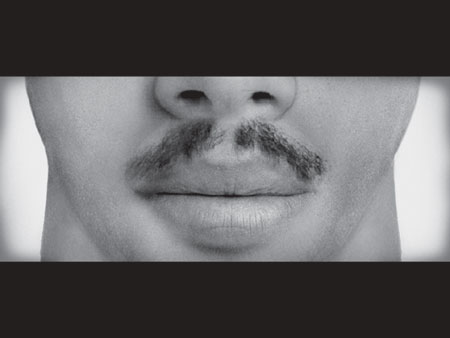
The Politics of Art
Artists
tackle life’s biggest issues with their
work.
By Vicky A. Clark
The art of our times changes before
our very eyes with sudden shifts and unexpected
turns that confuse and unnerve us. Combine that
thrill and challenge with world-wide twists
and turns, and we are left with a feeling of
vertigo in both our personal and public lives.
How can we make sense of the world in which
we live? Can art help us to process and understand
change?
Laura Hoptman’s fresh, multi-faceted
look at the art of our times raises this possibility.
In her catalogue essay, she quotes philosopher
Theodor Adorno: “‘In order for a
work of art to be purely and fully a work of
art, it must be more than a work of art…’”
explaining that “art [is] capable of bearing
the burden of exploring territories traversed
by philosophy, religion, political ideology,
and science” and that “artists in
the show have [chosen] art as a meaningful vehicle
through which to confront fundamentally human
questions: the nature of life and death, the
existence of God, the anatomy of belief.”
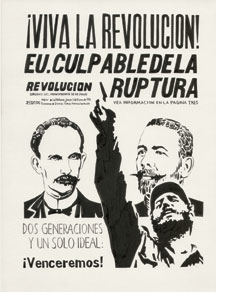 Hoptman
suggests that art can play an important role
in our lives. Artists can raise issues and suggest
different solutions, roles usually reserved
for those in other disciplines such as leaders
in politics, religion, science, and philosophy.
Artists’ creativity and imagination—often
ignored or seen as marginal fluff in an age
ruled by rationalism, logic, and empiricism—add
another voice to these discussions. Hoptman
suggests that art can play an important role
in our lives. Artists can raise issues and suggest
different solutions, roles usually reserved
for those in other disciplines such as leaders
in politics, religion, science, and philosophy.
Artists’ creativity and imagination—often
ignored or seen as marginal fluff in an age
ruled by rationalism, logic, and empiricism—add
another voice to these discussions.
However, it is difficult to measure
if including art in our larger discourse has
an impact. In fact, there is no proof that any
work of art actually changed history or the
way we think. Even Picasso’s Guernica—usually
considered the most political work of art—did
not end the Spanish Civil War. From the very
beginning, however, there have been high hopes
for art—whether by hunters looking forward
to a successful hunt, Egyptian pharaohs and
Roman emperors populating their lands with their
own image to assert their power and control,
or Christians carving Bible stories onto medieval
cathedrals to spread the word of their religion.
Much later, the Nazis, who advocated social
realism, organized the Exhibition of Degenerate
Art to distinguish between proper and immoral
art.
Throughout the history of the
International, we can see how hopes have been
raised periodically for art’s efficacy
in a larger context. At the very beginning,
Andrew Carnegie—like other philanthropists
in the Gilded Age—believed that his palace
of culture would improve the quality of life
of Pittsburghers, bringing them “sweetness
and light” through the civilizing and
educational power of art. After experiencing
the visualization of manifest destiny in the
White City of Chicago’s World’s
Fair in 1893, where 21.5 million paid to see
some 65,000 exhibits documenting success and
innovation, Carnegie wanted Pittsburgh to play
a similar role. At a time when the American
character was being defined and the country
was entering into world politics as a strong
contender, he suggested that American art belonged
with European art as an example of the triumph
of American ingenuity and culture.
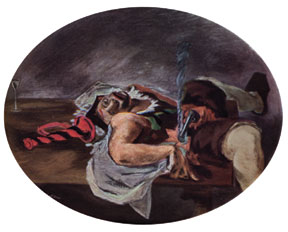 Many
artists took a political stance during the world
wars and the intervening Depression, from the
pointed criticism in Picasso and the German
Expressionists to the alternative world in Surrealism
and the rebellious actions of the Dadaists.
Rarely did such politics cause a stir at the
International, though, Franklin Watkins’
Suicide in Costume, which won the top
prize in 1931, was troublesome. He equated his
robust, dead clown prone on a table with a gun
with “our civilization” during the
deep Depression. Unlike usual aesthetic debates,
this work engendered uproar about the proper
subject and role of art. The public outcry was
addressed in a local article It’s Ugly
But Is It Art? International Curator
Homer St. Gaudens later claimed that the exhibition
was “the laboratory wherein was touched
off the fuse that exploded the charge that within
the last two decades blew up the illusions of
self-contented ignorance.” Many
artists took a political stance during the world
wars and the intervening Depression, from the
pointed criticism in Picasso and the German
Expressionists to the alternative world in Surrealism
and the rebellious actions of the Dadaists.
Rarely did such politics cause a stir at the
International, though, Franklin Watkins’
Suicide in Costume, which won the top
prize in 1931, was troublesome. He equated his
robust, dead clown prone on a table with a gun
with “our civilization” during the
deep Depression. Unlike usual aesthetic debates,
this work engendered uproar about the proper
subject and role of art. The public outcry was
addressed in a local article It’s Ugly
But Is It Art? International Curator
Homer St. Gaudens later claimed that the exhibition
was “the laboratory wherein was touched
off the fuse that exploded the charge that within
the last two decades blew up the illusions of
self-contented ignorance.”
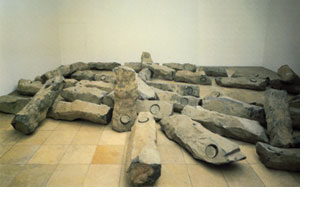 In
1988, the International preceded the
end of the millennium debate. Joseph Beuys’
End of the Twentieth Century anchored
a somber show where artists addressed AIDS,
consumerism, gender, and politics. Julian Schnabel
used St. Sebastian as a symbol for AIDS, Anselm
Kiefer referenced the Holocaust, and Elizabeth
Murray used the kitchen table to address gender
issues. These issues were part of the next several
Internationals, though politics was
never the core of any exhibition. In
1988, the International preceded the
end of the millennium debate. Joseph Beuys’
End of the Twentieth Century anchored
a somber show where artists addressed AIDS,
consumerism, gender, and politics. Julian Schnabel
used St. Sebastian as a symbol for AIDS, Anselm
Kiefer referenced the Holocaust, and Elizabeth
Murray used the kitchen table to address gender
issues. These issues were part of the next several
Internationals, though politics was
never the core of any exhibition.
In each of these cases, the hopes
for works of art outpaced the expectations of
the viewers and curators and even the artists
themselves. Rarely is politics the raison d’etre
of a work, and rarely are politics completely
absent. Even pure abstraction can have political
overtones.
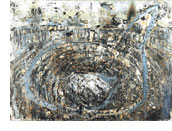 We
cannot measure the effect of art upon those
that see it, nor can we prove that the claims
and hopes attached to art in the last 106 years
were realized. However, this year’s International
signals a shift. The art here, too, bears the
burden of expectations. Many of the artists
have chosen the commonplace as their subject
while contributing to the larger discussions
of the meaning of life, adding different points
of view. Perhaps the arts will regain their
place in the make-up of the Renaissance man
and begin to move away from the over-specialization
and isolation of contemporary knowledge and
research. At the very least, they are storming
the gates, demanding to be relevant, contributing
new perspectives, and giving new hopes to their
creators. n We
cannot measure the effect of art upon those
that see it, nor can we prove that the claims
and hopes attached to art in the last 106 years
were realized. However, this year’s International
signals a shift. The art here, too, bears the
burden of expectations. Many of the artists
have chosen the commonplace as their subject
while contributing to the larger discussions
of the meaning of life, adding different points
of view. Perhaps the arts will regain their
place in the make-up of the Renaissance man
and begin to move away from the over-specialization
and isolation of contemporary knowledge and
research. At the very least, they are storming
the gates, demanding to be relevant, contributing
new perspectives, and giving new hopes to their
creators. n
About the author
Vicky A. Clark held a
number of positions at Carnegie Museum of Art
from 1981 to 1996. Her last project was the
book International Encounters: The Carnegie International and Contemporary Art, 1896–1996.
After six years as curator at the Pittsburgh
Center for the Arts, she is now an independent
curator working on exhibitions across the country
and a professor at various local universities.
Back to Contents |